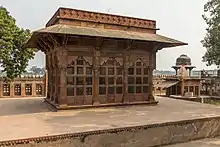Jaswant Ki Chhatri
Jaswant Singh ki chhatri (or Jaswant ki chatri) is a domed pillared pavilion shaped cenotaph, common to Rajasthani architecture, built in c. 1644–58 AD, by Jaswant Singh Rathore in memory of his elder brother Amar Singh Rathore's wife Rani Hada . The chhatri is situated in Rajwara, Balkeshwar, along the banks of river Yamuna, in Agra, and is now maintained by Archaeological Survey of India (ASI) as a monument of National importance.[1][2]

History
The chhatri was built in 1644–58 AD, dedicated to Rani Hada, princess of Bundi in Rajasthan, who was married to Amar Singh Rathore. Amar Singh Rathore was killed on 25 July 1644 at Agra Fort. His body was given to widow Hada Rani who committed sati at the spot. Raja Jaswant Singh, younger brother of Amar Singh Rathore, built this commemorative Chhatri.
The chhatri is not of Raja Jaswant Singh II, who died and was cremated at Jamrud, Khyber pass, in 1678. Later, his chhatri was built at Mandor, in Jodhpur, known as Jaswant Thada.[3]
Architecture
The chattri is a unique feature of Rajput architecture, a feature mostly seen in Shekhawati areas of Rajasthan. Surrounded by a rectangular baradari, the structure with twelve pillars of red sandstone is known for Jali (mesh work in stone). The stone work is similar to that at Agra Fort and is popularly known as Agra Jali.
References
- Agra: historical & descriptive, by Syad Muhammad Latif. Oriental Publishers & Booksellers, 1981. p. 192
- Monuments of National Importance: Agra Circle #4 Jaswant SIngh Ki Chhatri, ASI Indian Archaeology Review, 1990-1991. p. 118
- Jaswant Singh Rajasthan, Delhi and Agra, Lonely Planet by Lindsay Brown, Amelia Thomas. Lonely Planet, 2008. ISBN 1741046904. p. 313